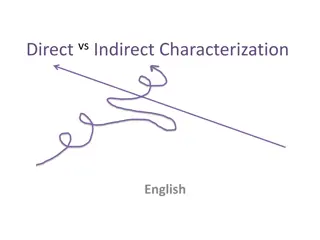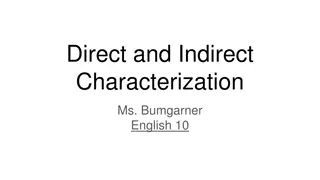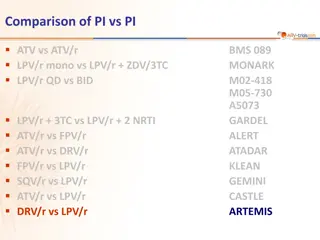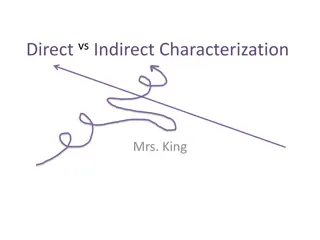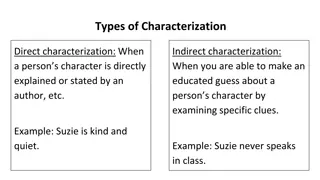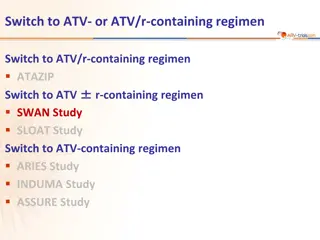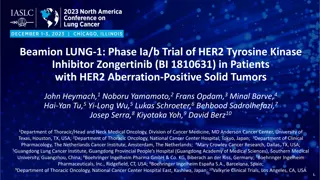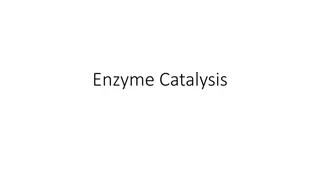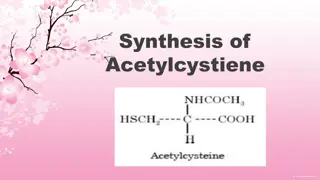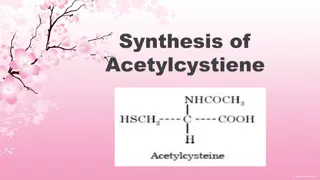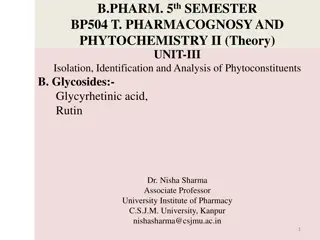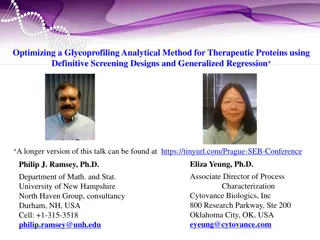Characterization of Cysteine Protease Inhibitor from Canavalia ensiformis
Uncontrolled proteolysis due to cysteine proteases imbalance is crucial in numerous pathological conditions. Canavalia ensiformis, known as the wonder bean, shows potential as a source of cysteine protease inhibitor. The study aims to isolate and characterize the inhibitor from this plant. Methods include sample collection, extraction, purification through ion exchange chromatography and gel filtration, and spectroscopic analysis. Results present purification data and a Lineweaver-Burk plot revealing competitive inhibition characteristics.
Download Presentation

Please find below an Image/Link to download the presentation.
The content on the website is provided AS IS for your information and personal use only. It may not be sold, licensed, or shared on other websites without obtaining consent from the author. Download presentation by click this link. If you encounter any issues during the download, it is possible that the publisher has removed the file from their server.
E N D
Presentation Transcript
5th FACULTY OF SCIENCE CONFERENCE LAGOS STATE UNIVERSITY OJO LAGOS STATE. PRESENTER : KANMODI RAHMON ILESANMI 1
INTRODUCTION Uncontrolled proteolysis resulting from an imbalance between cysteine proteases and their inhibitors play a critical role in a wide spectrum of pathological processes. Cysteine proteases (EC 3.4.22) : also known as thiol proteases, are enzymes that degrade proteins (Jinka et al., 2009) . Cysteine protease inhibitor (CPI): are responsible for the stringent regulation and control of activities of these enzymes (Corrion et al., 2010). Plants distinguished by their ability to continuously grow under extreme environmental conditions such as nutrient-depleted, highly leached and acidic soil are rich sources of CPI. 2
INTRODUCTION CONTD Wonder bean (Canavalia ensiformis): is a climbing perennial legume widely cultivated in humid tropics of Asia and Africa (Malviya et al., 2010). Investigation of C.ensiformis for CPI properties provided clue of its potential to efficiently regulate cysteine protease activities . 3
INTRODUCTION CONTD Fig. Canavalia ensiformis leaves 4
INTRODUCTION CONTD Fig : Canavalia ensifromis seeds 5
AIM To isolate and characterise cysteine protease inhibitor from Canavalia ensiformis. 6
METHODS SAMPLE COLLECTION AND PREPARATION EXTRACTION AND ISOLATION PURIFICATION ION EXCHANGE CHROMATOGRAPHY GEL FILTRATION SPECTROPHOTOMETRIC ANALYSIS SDS PAGE 7
RESULTS Table 1. Purification table of cysteine protease inhibitor (CPI) from Canavaila ensiformis Sample Total Inhibitory Specific inhibitory Protein Activity Purification Protein (mg) activity(units) activity( unit/mg) yield (%) yield (%) fold Crude 90.0 1330 14.7 100 100 1 extract Ammonium 46.0 990 22 50 74.4 1.4 sulphate Fraction (65%) Ion Exchange 25.0 1220 48.8 27.8 91.7 3.3 chromatography (DEAE-cellulose) Gel filtration (Sephadex G-100) 11.0 1110 99.1 12.2 81.0 6.7 8
RESULTS CONTD Figure 1. Lineweaver-Burk plot of purified CPI. In the absence and presence of purified inhibitor extract, the reciprocal of the varying amount of substrate concentration [1/S] used and the reciprocal of the absorbance (1/V) at 280 nm were plotted against each other. The double reciprocal plot shows that inhibition is competitive having the same Vmax of 78.59 mol/min, different Km =209 M and Ki= 137 M. [Vi]= with inhibitor and [Vo] = without inhibitor 9
RESULTS CONTD 60 40 35 50 30 40 % inhibition 25 % inhibition 20 30 15 20 10 10 5 0 0 6 6.5 7 7.5 8 8.5 9 0 10 20 30 40 50 60 70 80 90 pH Temperature (oc) Figure 3. Optimum pH of purified cysteine protease inhibitor Figure 2. Optimum temperature of purified cysteine protease inhibitor. 10
RESULTS CONTD 120 120 120 residual inhibitory activity(%) 100 100 100 80 80 residual inhibitory activity 80 residual inhibitory 60 60 60 activity ( %) 40 40 40 20 20 20 0 0 0 % concentraton of Mg2+ (mM) concentraton of Co2+ (mM) concentraton of Zn2+ 120 120 120 residual inhibitory activity 100 100 100 80 80 residual inhibitory residual inhibitory 80 60 60 residual inhibitory 60 activity (%) 40 40 40 activity (%) 20 20 % 20 0 control 1mM 2mM 4mM 6mM 8mM 10mM 0 0 concentraton of Cu2+ (mM) concentraton of Mn2+ (mM) concentraton of Pb2+ (mM) Figure 4: Effect of metal on CPI activity. At concentration as low as 1mM, divalent metal ; Pb2+, Mg2+, Co2+, Mn2+, Zn2+ and Cu2+decreased the residual cysteine protease inhibitory activity . 11
RESULTS CONTD S M KDa 112 74 52 45 32 28 18.4 14.4 Fig 5. SDS-PAGE analysis for the purified cysteine protease inhibitor. The gel pattern of the cysteine protease inhibitor fraction when subjected to SDS-PAGE yielded a double polypeptide band with a molecular weight of 28 and 32kDa. M= marker; S = sample. 12
DISCUSSION CPI from C.ensiformis exhibited optimal activity at temperature and pH of 40 C and 8.0 respectively. Maximum inhibitory effect of Isolated cysteine protease inhibitor from Canavalia ensiformis seeds was observed with 65% ammonium sulfate precipitation . Interactions of metal ions such as Mg2+, Pb2+, Cu2+, Mn2+, Zn2+, and Co2+ with cysteine protease inhibitor from Canavalia ensiformis showed that some metals enhanced the inhibitory activity of cysteine protease inhibitor while some reduced its activity. 13
DISCUSSION CONTD The mechanism of inhibition of purified cysteine protease inhibitor from Canavalia ensiformis is competitive , yielding the same Vmax. The result of SDS PAGE analysis revealed two polypeptide bands with molecular weight of 28 and 32 KDa. This suggests that a splitting of the polypeptide chain might have occurred or there might be two different cysteine protease inhibitors present. The physiochemical properties exhibited by the CPI from Canavalia ensiformis is similar to that obtained in previous studies. This makes it an attractive candidate for potential utilization as a pharmaceutical agent in the treatment of pathological conditions such as cancer and neurodegenerative diseases. 14
CONCLUSION The cysteine protease inhibitor from Canavalia ensiformis were successfully isolated and there was an indication that it is composed of two polypeptide chains that might have been denatured under reducing condition in the presence of -mercaptoethanol.However, further investigation is required to verify this. 15
REFERENCES Arun A, Sridhar K, Raviraja N, Schmidt E and Jung K (2003) Nutritional and antinutritional components of Canavalia spp. seeds from the west coast sand dunes of India. Plant Foods for Human Nutrition58:1-13. Ashouri S, Abad RFP, Zihnioglu F and Kocadag E (2017) Extraction and purification of protease inhibitor (s) from seeds of Helianthus annuus with effects on Leptinotarsa decemlineata digestive cysteine protease. Biocatalysis and Agricultural Biotechnology 9:113-119. Chee YKH, J. B.; Ramirez, L. ; Chen, C. P., (1992) Canavalia ensiformis (L.) DC. Record from Proseabase. Mannetje, L.'t and Jones, R.M. (Editors). PROSEA (Plant Resources of South-East Asia) Foundation, Bogor, Indonesia. Obayomi A, Adeola S, Bankole H and Raimi O (2015) Characterization of partially purified cysteine protease inhibitor from Tetracarpidium conophorum (African walnut). African Journal of Biochemistry Research9:26-34. Udedibie A and Carlini C (1998) Questions and answers to edibility problem of the Canavalia ensiformis seeds a review. Animal Feed Science and Technology74:95-106. 16


